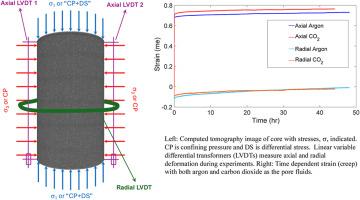氩气和CO2作用下裂缝性页岩盖层的弹性和蠕变行为
IF 7.5
1区 工程技术
Q1 ENGINEERING, GEOLOGICAL
International Journal of Rock Mechanics and Mining Sciences
Pub Date : 2025-09-17
DOI:10.1016/j.ijrmms.2025.106279
引用次数: 0
摘要
采用氩气和二氧化碳作为孔隙流体,对Eagle Ford地层的裂缝/微裂缝页岩样品进行了一系列三轴应力、不排水蠕变试验。每次蠕变试验由2天的“加载”蠕变和1天的“恢复”蠕变阶段组成。在每个“加载”蠕变阶段的开始和结束时收集迟滞周期和超声波速度。此外,我们对其中一个样品进行了为期7天的二氧化碳注射试验,并每24小时研究一次迟滞行为。在进行了较长时间的二氧化碳蠕变试验的第2天后,迟滞现象没有发生明显变化,然而,卸载期间(在结束蠕变试验时)的杨氏模量明显大于2天二氧化碳试验的卸载杨氏模量。我们进一步实现了一个概念蠕变模型来分解蠕变试验期间/之后的弹性、塑性、粘弹性和粘塑性变形。幂律和伯格的蠕变模型被用来预测这些标本的长期行为。虽然裂缝/微裂缝丰富,但与典型页岩相比,样品表现出中等至较大的初始杨氏模量和低至中等的初始蠕变变形。我们观察到CO2测试的杨氏模量较小,幂律模型中的柔度参数B较大,Burger模型中的E1参数较低,证实了这一点。从Burger的模型中,蠕变应变分别与幂律指数n和参数η1呈正相关和负相关。在CO2试验中观察到较大的粘弹性变形,分别由较大的n和较小的η1值证实。最后,动态泊松比(由超声速度获得)明显大于静态泊松比,而加载和卸载期间动态杨氏模量的差异可以忽略不计。本文章由计算机程序翻译,如有差异,请以英文原文为准。

Elastic and creep behavior of fractured shale caprocks in the presence of argon and CO2
A series of triaxial stress, undrained creep tests is reported for fractured/micro-cracked shale specimens from the Eagle Ford formation using argon and CO2 as the pore fluids. Each creep test was composed of a 2-day “loading” creep and a 1-day “recovery” creep stage. Hysteresis cycles and ultrasonic velocities were collected at the beginning and end of each “loading” creep stage. In addition, we conducted a 7-day CO2-injection test on one of the samples and investigated the hysteresis behavior every 24 h. No significant changes in hysteresis were observed after day 2 of the longer-term CO2 creep test, however, the Young's modulus during unloading (upon concluding the creep test) was notably greater compared to the unloading Young's modulus of the 2-day CO2 test. We further implemented a conceptual creep model to decompose the elastic, plastic, viscoelastic, and viscoplastic deformations during/after creep tests. Power-law and Burger's creep models were used to predict the longer-term behavior of these specimens. While fractures/micro-cracks were abundant, the samples exhibited moderate-to-large initial Young's modulus and low-to-moderate initial creep deformation compared to typical shale rocks. We observed smaller Young's modulus for the CO2 tests, as confirmed by a greater compliance parameter B in the power-law model and lower E1 parameter in Burger's model. Creep strain exhibited positive and negative correlations with the power-law exponent, n, and parameter η1 from Burger's model, respectively. Larger viscoelastic deformations were observed during CO2 tests, as confirmed by the larger n and smaller η1 values, respectively. Lastly, the dynamic Poisson's ratios (obtained from ultrasonic velocities) were significantly larger than their static counterparts, while the difference in dynamic Young's moduli during loading and unloading was negligible.
求助全文
通过发布文献求助,成功后即可免费获取论文全文。
去求助
来源期刊
CiteScore
14.00
自引率
5.60%
发文量
196
审稿时长
18 weeks
期刊介绍:
The International Journal of Rock Mechanics and Mining Sciences focuses on original research, new developments, site measurements, and case studies within the fields of rock mechanics and rock engineering. Serving as an international platform, it showcases high-quality papers addressing rock mechanics and the application of its principles and techniques in mining and civil engineering projects situated on or within rock masses. These projects encompass a wide range, including slopes, open-pit mines, quarries, shafts, tunnels, caverns, underground mines, metro systems, dams, hydro-electric stations, geothermal energy, petroleum engineering, and radioactive waste disposal. The journal welcomes submissions on various topics, with particular interest in theoretical advancements, analytical and numerical methods, rock testing, site investigation, and case studies.

 求助内容:
求助内容: 应助结果提醒方式:
应助结果提醒方式:


